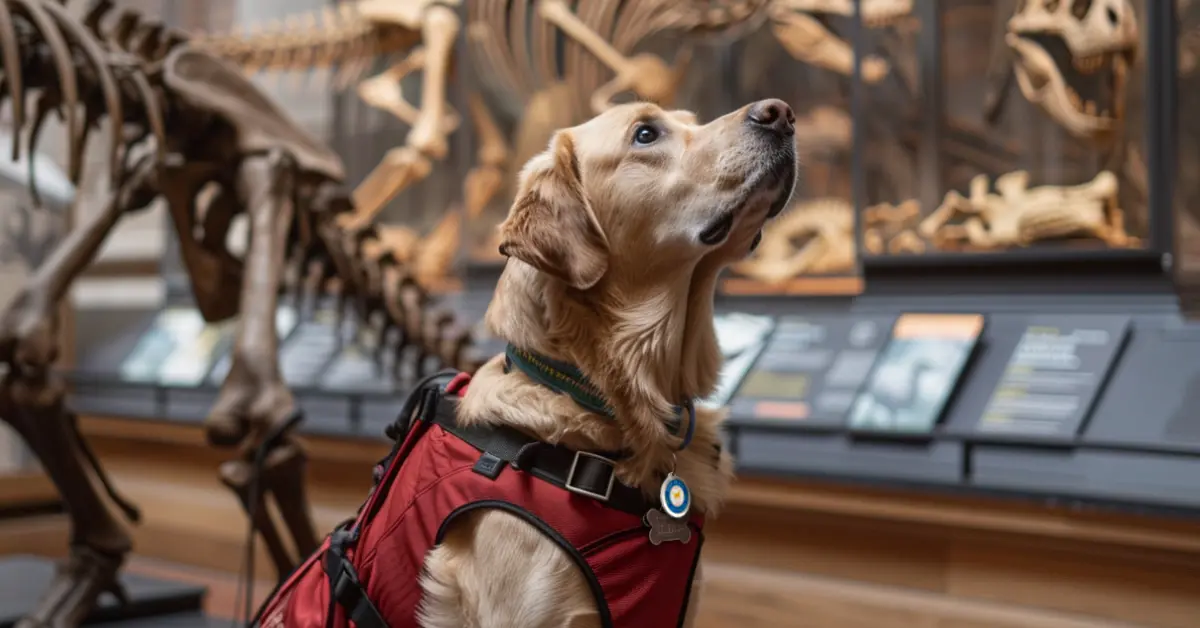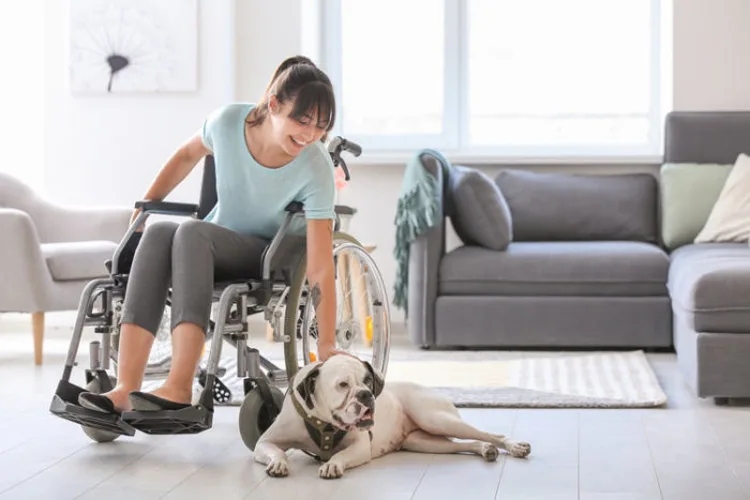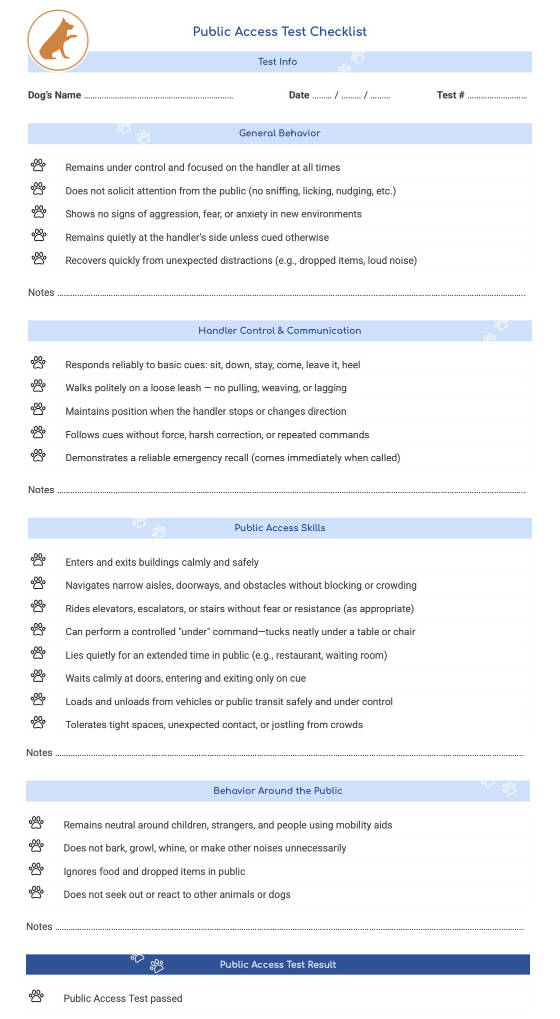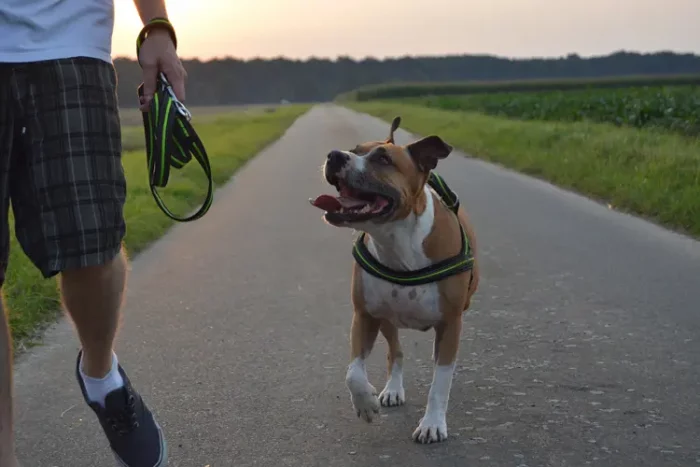What is a Public Access Test for Service Animals?

A public access test checks whether your service dog behaves well in places where regular pets are not allowed. The point is to ensure your dog remains calm in noisy environments, refrains from chasing food on the floor, responds to commands promptly, and can still perform their service dog tasks even in the presence of numerous distractions. Passing this test shows your dog is ready to assist you in public.
Here are 5 key facts to know about service dog public access tests:
- To pass, your service dog must remain calm, focus on you, and perform tasks reliably despite distractions.
- The test evaluates behavior in stores, restaurants, and public places with real-world challenges.
- Professional trainers offer testing services, but you can also self-test.
- The ADA doesn’t require certification, but documentation can help.
- Preparation involves gradual exposure to various environments, challenges, and distractions.
Making sure your service dog can pass a public access test matters because a business or public area can lawfully deny your service dog if it’s out of control or misbehaving. Read on to learn everything you want to know about public access tests.
In this article:
- Core public access skills for service dogs
- Public access legal requirements and documentation
- Public access test checklist
- A real-world example of a public access test
- Breed considerations in public access testing
- Finding a qualified evaluator
Core Public Access Skills for Service Dogs
Successfully passing a public access test requires your dog to master three fundamental skill areas.
Being Calm in Public
Being calm in public starts with handling the sensory overload that comes with busy environments. Your dog needs to take in the chaos of shopping malls, restaurants, and medical facilities without becoming overwhelmed.
Those automatic doors that whoosh open unexpectedly? No big deal. That toddler who screams at the top of their lungs when they spot a dog? Just background noise. The polished floor that looks nothing like any surface in your home? All in a day’s work.
Physical self-control is equally important. Your service dog needs to maintain positions for extended periods without the fidgeting that would drive a kindergarten teacher crazy, like when you’re flying with your service dog. They need to walk through tight spaces without colliding with store displays and keep all four paws firmly planted on the ground, rather than jumping up in excitement.
Perhaps the most challenging part is social neutrality. Dogs are naturally social creatures who typically love attention from humans. Your service dog needs to ignore well-meaning strangers who make kissy noises and baby talk, children who squeal “Doggy!” at full volume, and even other dogs who might be giving them the canine equivalent of “Hey, wanna hang out?” This goes against everything in their friendly dog nature, which is why it takes so much practice.
Focusing on the Handler
The second key skill is handler focus — your dog’s ability to maintain an invisible tether of attention between you, regardless of what’s happening around them.
Good service dogs check in with their handlers regularly, making eye contact without being prompted. They position themselves based on the handler’s movements, matching pace and direction naturally. It’s almost like they’re reading your mind, but it’s actually the result of countless hours of reinforcing this connection.
Beyond attention, your dog must respond to commands immediately. A service dog who “gets around to it eventually” when asked to sit isn’t reliable enough for public work. Commands need to work the first time, every time, whether you’re in your quiet living room or a busy airport terminal.
Spatial awareness is another aspect of handler focus. Your service dog should maintain proper positioning without constant reminders. If they drift too far away, they should correct themselves. If you drop the leash, they should notice and stay with you rather than seeing it as an opportunity for independence.
Performing Tasks With Distractions
The third essential skill is reliable task performance despite distractions. After all, the whole purpose of a service dog is to perform tasks that help with your qualifying disability.
Your dog needs to recognize when it’s time to work, whether that’s responding to a command you give or, in some cases, alerting to conditions they’re trained to detect (like blood sugar changes or an oncoming seizure). They should begin their tasks promptly and complete them fully without getting sidetracked.
Task accuracy must remain consistent regardless of the environment. A retrieval dog who can pick up your keys at home but gets distracted halfway back to you at the grocery store isn’t ready for public access. Tasks need to be performed correctly every time, which requires practicing them in increasingly challenging environments.
What happens when things go wrong? Even the best-trained dogs occasionally get distracted. The difference lies in the recovery — how quickly they refocus and return to work. Service dogs need resilience to bounce back from distractions and continue helping their handlers.
Public Access Legal Requirements and Documentation
This may come as a surprise, but ADA service dog rules actually don’t require any form of certification or formal testing for service dogs, including public access tests.
So why bother with public access testing if it’s not legally required? Public access tests are important because your service dog can be asked to leave if it misbehaves, and a service dog that fails to handle its tasks in public environments can be dangerous for its handlers. Passing a public access test gives you peace of mind that your service dog can perform its duties in real-world settings.
You don’t need a certificate, but getting a handler certified public access test certificate helps document your dog’s skills, commemorates a significant achievement, and provides additional reassurance to third parties who might question your dog’s training.
Order Your PAT CertificatePublic Access Test Checklist
Here is a sample checklist you can use when evaluating a service dog’s public access readiness:
Download a printable version of this sample checklist for your convenience (for educational purposes only).
A Real-World Example of a Public Access Test
Here’s what a public access test might look like:
Caleb wanted to conduct a comprehensive self-administered public access test for his service dog Juniper. With a detailed checklist in hand, he planned a three-hour assessment across multiple environments.
Starting in a shopping center parking lot, Caleb tested Juniper’s vehicle exit behavior. She remained seated until given her release word, “free,” despite nearby distractions. Moving through the lot, she maintained a consistent heel position and showed appropriate response when a shopping cart rattled by, noticing but not reacting.
At the mall entrance, Juniper waited calmly for Caleb’s forward cue before navigating the slick floors confidently. She maintained focus despite passing a noisy children’s play area, demonstrating good distraction resistance.
In a department store, Juniper showed excellent spatial awareness, tucking behind Caleb in narrow aisles without prompting. When he deliberately dropped his wallet, she alerted him and retrieved it on command, performing her task perfectly amid store distractions and ignoring nearby dog toys.
The food court provided an ideal settling test. Juniper maintained a down position under the table for 25 minutes while people dropped food nearby and announcements played overhead. During a controlled greeting interaction with a store employee, she remained seated without excessive excitement, returning to work mode immediately afterward.
For the separation assessment, Caleb secured Juniper to a bench and observed from a distance. After initially watching him leave, she settled calmly without vocalizing or pulling. When a store alarm suddenly activated, Juniper startled but recovered quickly, though Caleb noted this as an area needing improvement.
At a café, Juniper stayed under the table out of the server’s path. When Caleb simulated a medical episode using their signal, she immediately performed her trained response—placing paws on his lap and licking his hand.
Their final assessment included public transportation elements. Juniper handled both elevator and escalator rides confidently, maintaining position in confined spaces and on moving surfaces.
After reviewing his notes, Caleb identified Juniper’s strengths: maintaining focus in crowds, reliable task performance, and excellent settling behavior. Areas needing improvement included recovery from sudden noises and extended periods of separation.
This comprehensive self-assessment gave Caleb confidence that Juniper met most public access standards while highlighting additional training goals. Caleb planned to do another, more comprehensive test in a few weeks.
Disability-Specific Considerations in Testing
The public access test evaluates whether a service dog team can work effectively; however, some handlers may require adaptations due to their disabilities. That means no single evaluation standard applies to all service dog teams, and a public access test might have to be adjusted.
Handlers with limited hand or arm mobility may use alternative techniques, such as hands-free leashes, extended harness handles, or custom equipment. Traditional leash handling may not be possible for those with arthritis, paralysis, or limb differences.
Non-speaking handlers or those with speech impairments might rely on visual signals, electronic devices, or body language. Evaluators should focus on how consistently the dog responds, not the type of communication used.
Handlers with cognitive or memory challenges may use simplified commands, cue cards, or digital reminders. Those with sensory differences might adapt their gear, like padded handles for tactile sensitivity or visual cues for auditory processing issues.
Ultimately, public access tests should assess the dog’s performance and behavior, rather than enforcing rigid methods. Adaptations are often necessary and valid ways for teams to succeed.
Breed Considerations in Public Access Testing
Physical characteristics and breed tendencies can influence how you approach public access training:
Small Breeds Under 25 lbs
Chihuahuas, Yorkshire Terriers, Miniature Poodles, and Papillons might be small in stature, but many excel as medical alert or psychiatric service dogs. During public access testing, small breeds often navigate crowded spaces with ease, fitting comfortably under restaurant tables and in tight quarters, such as airplane cabins or bus seats. Their size makes them nearly invisible in many settings — a genuine advantage for handlers who prefer discretion.
However, their small stature presents unique challenges during testing. Evaluators often pay special attention to a small dog’s confidence level, as they need to demonstrate they aren’t intimidated by environments designed for much larger humans and animals. A Yorkshire Terrier must show the same willingness to walk past loud machinery or large crowds as a German Shepherd, despite the greater impact these stimuli might have from their lower vantage point.
When demonstrating tasks during testing, small dogs must exhibit adaptations that are appropriate to their size. While they can’t perform heavy mobility work, they excel at retrieving small dropped items, activating emergency call buttons, or providing deep pressure therapy, even with their limited weight.
Medium Breeds 25-50 lbs
Border Collies, Cocker Spaniels, Standard Poodles, and Australian Shepherds represent the middle range, combining moderate strength with manageable size. During public access testing, these breeds often demonstrate outstanding versatility, able to navigate tight spaces while still performing more strength-dependent tasks.
Medium breeds typically excel in the public behavior portions of testing, as they’re large enough to be taken seriously as working dogs but small enough to maneuver easily in public settings. A Border Collie can comfortably settle under a standard restaurant table while still having the presence to create personal space for their handler in crowded environments when needed.
During testing, handlers of medium breeds — particularly those with working or herding backgrounds, like Border Collies — must demonstrate their dog’s ability to override natural instincts. Evaluators might pay special attention to how these dogs respond to moving objects, children running, or other stimuli that might trigger herding behaviors.
Large Breeds Over 50 lbs
Labrador Retrievers, German Shepherds, Golden Retrievers, and Standard Poodles in the larger size range bring presence and strength to service work. During public access testing, these breeds must demonstrate exceptional spatial awareness and body control despite their size. An evaluator will watch closely as a 75-pound Labrador navigates tight store aisles without bumping displays or manages narrow spaces between restaurant tables.
Large breeds face their greatest testing challenges in settling unobtrusively in public. A German Shepherd must show the ability to tuck completely under a restaurant table or beside a chair in a waiting room without extending into walkways. Their size means they must be remarkably disciplined about maintaining their designated position, as they can’t easily be moved or redirected once settled.
During testing, larger breeds also face unique perceptual challenges from the public. Because they’re often perceived as “real” service dogs (based on popular media portrayals), evaluators sometimes hold them to even higher behavioral standards.
Finding a Qualified Evaluator
When you’re ready to put your dog’s skills to the test, you have a few different options — some more formal than others. Unlike a driver’s test or a school exam, there is no single official authority that administers public access tests for service dogs, which can make the process a bit confusing at first.
Many handlers choose to work with service dog trainers who specialize in assistance animal work. These professionals understand the nuances of public access behavior and can offer a thorough, objective evaluation. It’s especially helpful to find a trainer with experience relevant to your disability and the specific tasks your dog performs. Professional evaluations typically range from $75 to $250, depending on your location and the trainer’s credentials.
That said, there’s no legal requirement to use a professional evaluator — you can administer a public access test yourself. This is especially common for owner-trainers. What matters most is that the test is fair, thorough, and based on realistic public scenarios. Self-testing allows you to go at your own pace and focus on areas that need improvement. Just be honest about your dog’s behavior and your own expectations.
Whether you go the professional or DIY route, the key is to approach testing as a tool for growth. A good evaluation — regardless of who conducts it — should be transparent, clearly outline what’s being assessed, and provide helpful feedback instead of a simple pass/fail judgment.
About the Author: The writing team at Service Dog Certifications is made up of folks who really know their stuff when it comes to disability laws and assistance animals. Many of our writers and editors have service dogs themselves and share insights from their own experiences. All of us have a passion for disability rights and animals.
8 comments
Leave a Reply Cancel reply
Latest Posts

Can you bring a service dog to a museum?
Yes, you can bring your service dog to the museum! All the major U.S. museums welcome guests with service animals in accordance with the Americans with Disabilities Act (ADA). There are some areas, however, that might be off-limits. Here’s what you should know if you plan to spend a day at the museum with your […]

Read More

How to Bring a Service Dog to Six Flags Magic Mountain
Service dogs are welcome at Six Flags Magic Mountain so long as they are, according to Six Flags, “trained to do work or perform tasks for people with disabilities.” Of course, your dog must be housebroken and remain on a leash or harness and under your control while at the park — and the park […]

Read More

When Stores Can Refuse Your Service Dog
According to the Americans with Disabilities Act (ADA), service dogs should be allowed into any store most of the time. A store owner can legally exclude a service dog if they are actively growling, snapping at, or frightening customers, or if the dog is obviously out of the control of its owner. Ordinary behaviors — […]

Read More



My dog assists with my bad hearing. My observation of him on leash lets me know things happening near by. Without some response from him I wouldn’t get alerts. That’s how we work together when on leash.
My six month old Cane Corso started smelling my breath the making me sit down by using his paw. I’m a recovering cancer patient and I have EHLERS-DANLOS Syndrome. After I sit he calms down and sits by me then gets up and looks at me like it’s ok. I train him in public on lead and off around noises people ect. He’s a good dog can he qualify for my alert dog?
We suggest speaking to your healthcare professional and perhaps a professional trainer to see if a service dog is appropriate for you.
If I train my dog myself can I perform the public access test or does someone else have to?
You can test your dog on your own or with the help of a professional trainer or organization.
Where would you get the test from and whom would you return it to for verification the dog passed. Also what legal paperwork would this give the Service Dog? Thank you
We do not administer a public access test. We offer a self-certifying document for handlers who have completed public access test criteria. It is not however a legal document (there are no “legal documents” required to own a service dog).
I put my golden retriever through a two-week training program. We are still working on training, but I would like to eventually set her up as my service dog. I can’t seem to find a way to officially get her certified as my service dog. Also, where can I get my dog to take the Public Access Test?